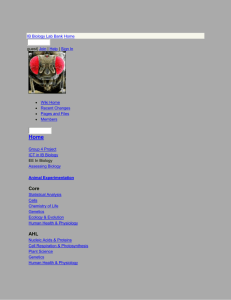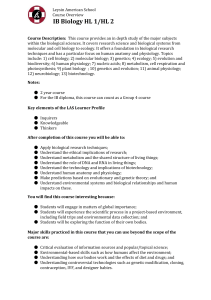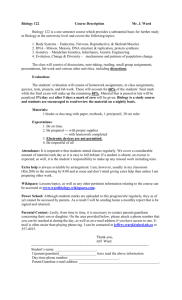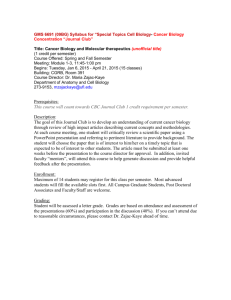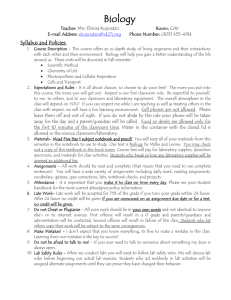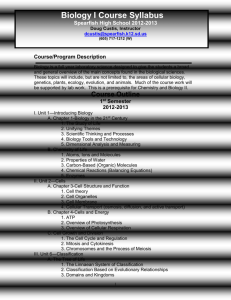AP Biology Syllabus
advertisement
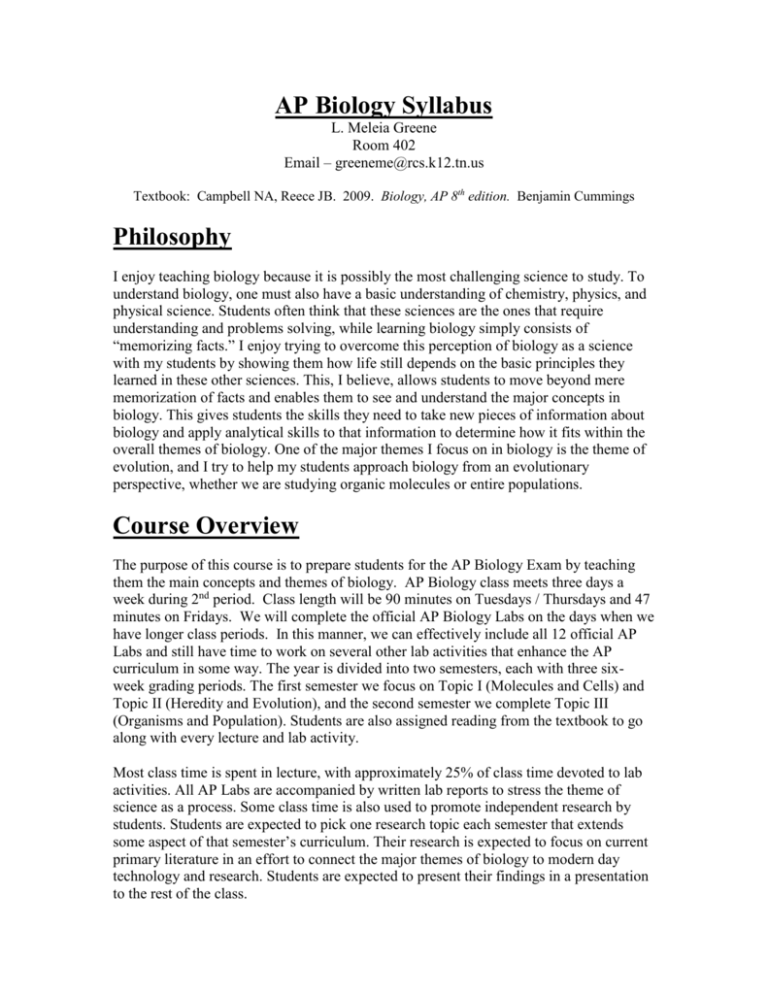
AP Biology Syllabus L. Meleia Greene Room 402 Email – greeneme@rcs.k12.tn.us Textbook: Campbell NA, Reece JB. 2009. Biology, AP 8th edition. Benjamin Cummings Philosophy I enjoy teaching biology because it is possibly the most challenging science to study. To understand biology, one must also have a basic understanding of chemistry, physics, and physical science. Students often think that these sciences are the ones that require understanding and problems solving, while learning biology simply consists of “memorizing facts.” I enjoy trying to overcome this perception of biology as a science with my students by showing them how life still depends on the basic principles they learned in these other sciences. This, I believe, allows students to move beyond mere memorization of facts and enables them to see and understand the major concepts in biology. This gives students the skills they need to take new pieces of information about biology and apply analytical skills to that information to determine how it fits within the overall themes of biology. One of the major themes I focus on in biology is the theme of evolution, and I try to help my students approach biology from an evolutionary perspective, whether we are studying organic molecules or entire populations. Course Overview The purpose of this course is to prepare students for the AP Biology Exam by teaching them the main concepts and themes of biology. AP Biology class meets three days a week during 2nd period. Class length will be 90 minutes on Tuesdays / Thursdays and 47 minutes on Fridays. We will complete the official AP Biology Labs on the days when we have longer class periods. In this manner, we can effectively include all 12 official AP Labs and still have time to work on several other lab activities that enhance the AP curriculum in some way. The year is divided into two semesters, each with three sixweek grading periods. The first semester we focus on Topic I (Molecules and Cells) and Topic II (Heredity and Evolution), and the second semester we complete Topic III (Organisms and Population). Students are also assigned reading from the textbook to go along with every lecture and lab activity. Most class time is spent in lecture, with approximately 25% of class time devoted to lab activities. All AP Labs are accompanied by written lab reports to stress the theme of science as a process. Some class time is also used to promote independent research by students. Students are expected to pick one research topic each semester that extends some aspect of that semester’s curriculum. Their research is expected to focus on current primary literature in an effort to connect the major themes of biology to modern day technology and research. Students are expected to present their findings in a presentation to the rest of the class. Course of Study The course is divided into ten units of study, with six units in Topics I and II covered in the first semester, and four units in Topic III covered in the second semester. The second semester is typically two to three weeks longer than the first, and I use the extra time to review key concepts on the AP Exam. All of the following topics are connected together using the eight major themes from the AP Biology Curriculum Topic I Unit 1 – Chemistry of Life Time: 2 weeks Lecture topics: Introduction to biology, experimental design Atomic structure and chemical bonding Chemistry of water, with a focus on properties that make it essential to life Organic chemistry – functional groups Biochemistry – carbohydrate, lipid, protein, and nucleic acid structure and function Energy and reactions, with the focus on ATP as the primary energy currency of cells Enzymes as biological catalysts Reading assignments: Chapter 1 – Introduction: Ten Themes in the Study of Life (p. 1-27) Chapter 2 – The Chemical Context of Life (p. 30-45) Chapter 3 – Water and the Fitness of the Environment (p. 46-57) Chapter 4 – Carbon and the Molecular Diversity of Life (p. 58-67) Chapter 5 – The Structure and Function of Large Biological Molecules (p. 68-91) Chapter 8 – An Introduction to Metabolism (p. 142-161) Lab activities: Organic Chemistry modeling kits – construction of simple lipids, carbohydrates, proteins, and amino acids (dry lab) AP Lab 2 – Enzyme Catalysis (wet lab) Unit 2 – Cells Time: 3 weeks Lecture topics: History of cell biology/cell theory, with a focus on development of the microscope Comparison of prokaryotic and eukaryotic cells Eukaryotic cell structure: major organelles and the endomembrane system Endosymbiont theory – as a connection to the theme of evolution Plasma membrane structure – fluid-mosaic model Cell cycle – mitosis Reading Assignments: Chapter 6 – A Tour of the Cell (p. 94-124) Chapter 7 – Membrane Structure and Function (p. 125-141) Chapter 11 – Cell Communication (p. 206-227) Chapter 12 – The Cell Cycle (p. 228-245) Lab activities: Introductory microscope lab – basic microscope use, with letter “e” slides made using wet mount technique Cell microscope lab – examination of bacteria, plant, and animal cells using prepared slides and wet mounts AP Lab 1 – Diffusion and Osmosis (wet lab) AP Lab 3 – Mitosis and Meiosis (mitosis portion only) (wet lab) Unit 3 – Cellular Energetics Time: 3 weeks Lecture topics: Coupled reactions, with a complete description of redox reactions Glycolysis and the Krebs cycle – substrate level phosphorylation Mitochondrial structure and electron transport – oxidative phosphorylation Chemiosmosis Fermentation – anaerobic respiration Light dependent and light independent reaction in photosynthesis Alternate photosynthetic pathways – C4 and CAM – and how they evolved as adaptations to dry conditions Reading Assignments: Chapter 9 – Cellular Respiration: Harvesting Chemical Energy (p. 162-184) Chapter 10 – Photosynthesis (p. 185-205) Lab activities: AP Lab 4 – Plant Pigments and Photosynthesis (wet lab) AP Lab 5 – Cell Respiration (wet lab) Topic II Unit 4 – Genetics Time: 2 weeks Lecture Topics: Meoisis, with a focus on its role in genetic variation, and how that variation can be of adaptive value Mendel’s experiments and conclusions – chromosomal inheritance Morgan and gene linkage Patterns of heredity – codominance, incomplete dominance, sex linkage, polygenic inheritance Reading Assignments: Chapter 13 – Meiosis and Sexual Life Cycles (p. 248-261) Chapter 14 – Mendel and the Gene Idea (p. 262-285) Chapter 15 – The Chromosomal Basis of Inheritance (p. 286-304) Lab activities: Lab 3 – Mitosis and Meiosis (meiosis portion only) (wet lab) Corn genetics lab – Analysis of Indian corn from a dihybrid cross AP Lab 7 – Genetic of Drosophila (wet lab) Unit 5 – Molecular Genetics Time: 3 weeks Lecture topics: History of the study of DNA, with a focus on key experiments DNA and RNA structure and function DNA replication, including enzymes involved and a comparison of leading/lagging strand synthesis Transcription, including post-transcriptional modification Translation and the effects of mutations Viral and bacterial genomes Gene regulation – operons (inducible and repressible) Biotechnology – PCR and electrophoresis Discussion of societal issues involving genetics – stem cell research, genetic engineering, etc. Reading Assignments: Chapter 16 – The Molecular Basis of Inheritance (p. 305-324) Chapter 17 – From Gene to Protein (p. 325-350) Chapter 18 – Regulation of Gene Expression (p. 351-380) Chapter 19 – Viruses (p. 381-395) Chapter 20 – Biotechnology (p. 396-425) Lab activities: AP Lab 6 – Molecular Biology (wet lab) Unit 6 – Evolution Time: 3 weeks Lecture topics: History of evolutionary theory Darwin’s development of evolution by natural selection Types of selection – adaptive radiation; sexual selection; directional, stabilizing, and disruptive selection Evidence for evolution Speciation, importance of reproductive isolation Introduction to phylogeny and the early evolution of life Reading Assignments: Chapter 22 – Descent with Modification: A Darwinian View of Life (p. 452-467) Chapter 23 – The Evolution of Populations (p. 468-486) Chapter 24 – The Origin of Species (p. 487-506) Chapter 25 – The History of Life on Earth (p. 507-533) Chapter 26 – Phylogeny and the Tree of Life (p. 536-555) Lab activities: Effect of natural selection on allele frequencies lab – uses different colored beans to simulate alleles (dry lab) AP Lab 8 – Population Genetics and Evolution (dry lab) Topic III – Organisms and Populations Unit 7 – Diversity Time: 5 weeks Lecture topics: History of classification and binomial nomenclature The traditional 5 kingdom system of classification Evidence for six kingdom classification and the addition of domains Diversity of bacteria – archaebacteria and eubacteria Diversity of Kingdom Protista Diversity of Kingdom Fungi Diversity of Kingdom Plantae – major divisions, focus on adaptations to terrestrial lifestyle Diversity of Kingdom Animalia – major phyla, focus on phylogenetic relationships and adaptations necessary for terrestrial lifestyle Reading Assignments: Chapter 27 – Bacteria and Archaea (p. 556-574) Chapter 28 – Protists (p. 575-599) Chapter 29 – Plant Diversity I – How Plants Colonized Land (p. 600-617) Chapter 30 – Plant Diversity II: The Evolution of Seed Plants (p. 618-635) Chapter 31 – Fungi (p. 636-653) Chapter 32 – Introduction to Animal Diversity (p. 654-665) Chapter 33 – Invertebrates (p. 666-697) Chapter 34 – Vertebrates (p. 698-735) Lab activities: Prokarya and Protista Lab – Survey of diversity using prepared slides and pond water specimens (wet lab) Plant Lab – Survey of Kingdom Plantae using preserved specimens and prepared slides (wet lab) Invertebrate Lab – Survey of the Invertebrate phyla using preserved specimens and prepared slides (wet lab) Vertebrate Lab – Survey of the phylum Chordata using preserved specimens and prepared slides (wet lab) Unit 8 – Plant Structure and Physiology Time: 2 weeks Lecture topics: Tissue types in plants, including vascular tissue (xylem and phloem) Seed structure, germination, and growth Primary and secondary structure and growth of stems and roots Structure and function of leaves and the control of stomata Transport of water due to cohesion-tension theory Plant hormones and their effects Plant responses to stimuli Reading Assignments: Chapter 35 – Plant Structure, Growth, and Development (p. 738-763) Chapter 36 – Resource Acquisition and Transport in Vascular Plants (p. 764-784) Chapter 37 – Soil and Plant Nutrition (p. 785-800) Chapter 38 – Angiosperm Reproduction and Biotechnology (p. 801-820) Chapter 39 – Plant Responses to Internal and External Signals (p. 821-849) Lab activities: Plant histology lab – Study of plant tissues using prepared slides (dry lab) AP Lab 9 – Transpiration (wet lab) Unit 9 – Animal Anatomy and Physiology Time: 4 weeks Lecture topics: General histology – types of tissue and function Circulation, evolution of vertebrate hearts and patterns of circulation Respiration, physiology of gas exchange and its regulation Digestion, human digestive tract and the regulation involved Excretion, the mammalian nephron, and the evolution of osmoregulation Immunology, nonspecific and specific Nervous system, neuron physiology and nervous system organization, senses Muscular system, sarcomeres and the sliding filament theory Reproduction, human structures, menstrual and ovarian cycles Endocrine system, blood glucose and calcium regulation, reproductive hormones Reading Assignments: Chapter 40 – Basic Principles of Animal Form and Function (p. 852-874) Chapter 41 – Animal Nutrition (p. 875-897) Chapter 42 – Circulation and Gas Exchange (p. 898-929) Chapter 43 – The Immune System (p. 930-953) Chapter 44 - Osmoregulation and Excretion (p. 954-974) Chapter 45 – Hormones and the Endocrine System (p. 975-996) Chapter 46 – Animal Reproduction (p. 997-1020) Chapter 47 – Animal Development (p. 1021-1046) Chapter 48 – Neurons, Synapses, and Signaling (p. 1047-1063) Chapter 49 – Sensory and Motor Mechanisms (p. 1087-1119) Lab activities: Animal histology lab – Study of animal tissues using prepared slides (dry lab) Dissection of the fetal pig (wet lab) Virtual dissection of the crayfish and earthworm using DissectionWorks software (dry lab) AP Lab 10 – Physiology of the Circulatory System (wet lab) Unit 10 – Ecology Time: 3 weeks Lecture topics: Population growth and regulation, limiting factors Predation, symbiosis, and coevolution Primary and secondary succession Flow of energy through ecosystems Biogeochemical cycles – nitrogen, carbon, and phosphorous Biomes, characteristics of aquatic ecosystems Threats to biodiversity – habitat destruction, introduced species Environmental concerns – global warming, ozone layer, acid rain Behavior – innate and learned Reading Assignments: Chapter 51 – Animal Behavior (p. 1120-1145) Chapter 52 – An Introduction to Ecology and the Biosphere (p. 1148-1173) Chapter 53 – Population Ecology (p. 1174-1197) Chapter 54 – Community Ecology (p. 1198-1221) Chapter 55 – Ecosystems (p. 1222-1244) Chapter 56 – Conservation Biology and Restoration Ecology (p. 1245-1267) Lab activities: Effect of acid rain on seed germination lab – exposes radish seeds to different pH solutions to determine effect on rate of seed germination AP Lab 11 – Animal Behavior (wet lab) AP Lab 12 – Dissolved Oxygen and Aquatic Primary Productivity (wet lab) AP Test Review Time: 2-4 weeks (depending on progress) Activities: Practice AP Tests Review lectures Focus on most commonly asked free response topics The Eight Major Themes in AP Biology I make every effort to connect class activities to the eight major themes of biology. This allows student to take everything they learn and incorporate into the “big picture.” Specific examples of the incorporation of each of these themes is as follows. I. Science as a Process: All AP Labs – My students complete a written lab report to accompany every AP Lab activity. In this, students analyze the data and the procedure itself. Graphical representations of data are required if applicable. Unit 4 –Genetics – We discuss Mendel’s classical experiments and examine his original data to determine how he formulated the law of segregation and the law of independent assortment before anything was known about DNA or chromosomes. II. Evolution: Unit 2 – Cells – We discuss in class the endosymbiont theory as an explanation for the origin and evolution of eukaryotic cells. Unit 7 – Diversity – We discuss the selective pressures that probably shaped the evolution of Kingdom Plantae in regards to their movement into a terrestrial environment. III. Energy Transfer: Unit 3 – Cellular Energetics – We discuss the idea of coupled reactions, explaining photosynthesis and respiration as redox reactions involving at some point the production of ATP though phosphorylation. We discuss how ATP acts as an “energy shuttle” within a cell. Unit 10 – Ecology – We discuss the idea of energy transfer through a food chain and its inherent inefficiency. IV. Continuity and Change Unit 5 – Molecular Genetics, and Unit 6 – Evolution – We discuss the various repair mechanisms of DNA to help prevent mistakes, but we also point out the importance of mutation as “new” sources of variation within a population for natural selection to act upon. Unit 7 – Diversity – We discuss the evolution of the animal kingdom with special attention to ancestral and derived characteristics. V. Relationship of Structure and Function: Unit 1 – Chemistry of Life – We discuss the importance of molecular 3D structure to a molecule’s function, with the focus on the lock-key theory of enzymesubstrate interaction. Unit 8 – Plant Anatomy and Physiology, and Unit 9 – Animal Anatomy and Physiology – We discuss the importance of the surface area to volume ratio in regards to cells, tissues, and organs that involved in transport of materials. Examples covered include water uptake by roots, transpiration across leaves, small intestine absorption of nutrients, and gas exchange in lungs. VI. Regulation Unit 5 – Molecular Genetics – We discuss how gene expression is regulated in prokaryotes using operons which can be either repressible or inducible. Unit 9 – Animal Physiology – We discuss the various hormonal feedback mechanisms of human systems, such as pancreatic regulation of blood glucose or pituitary regulation of reproductive cycles. VII. Interdependence in Nature Unit 3 – Cellular Respiration – We discuss how photosynthesis and respiration are complementary process, as the reactants of photosynthesis are the products of respiration and vice versa. Unit 10 – Ecology – We describe how predator-prey interactions help regulate population sizes and how they can lead to coevolution. VIII. Science, Technology, and Society Unit 5 – Molecular Genetics – We discuss how our increasing knowledge of DNA opens the possibility of things like cloning and genetic engineering and how that could affect society. Unit 10 – Ecology – We discuss how humans are impacting the environment and what consequences we may face in the future as a result. Student Evaluation Students are evaluated using tests, homework assignments, lab reports, and semester projects according to the following percentages. Tests – 60% Homework – 10% Labs – 20% Project – 10% Tests are written in the format of the AP tests, with 60% of each test grade coming from multiple choice questions and 40% coming from free response questions. Homework includes practice quizzes with AP style multiple choice questions and practice free response questions that cover the AP content. I pull many of these sample free response questions from the University of Georgia’s AP Biology Review site - http://biosciences.uga.edu/ap_biology/index.html Labs include any lab activity. AP Labs are evaluated based on lab reports the students turn in. The lab reports contain section titled Introduction, Materials & Methods, Results, and Discussion. Students write the lab reports on graph paper and are expected to produce graphical representations of their data in the proper format whenever possible. Other labs are evaluated based on labeled sketches, data sheets, or worksheets with questions. Each semester students will complete projects based on the topic of their choice. Students are expected to select a research topic that in some way extends the normal AP Biology Curriculum. Students select a topic from AP Biology Topics I and II for the first semester and from Topic III for the second semester. Their grade depends on the submission of a list of annotated sources from the primary literature (scientific journals), submission of a research paper with citations in the text, and a Powerpoint presentation made to the class at the end of the semester.
